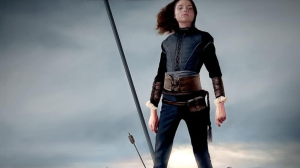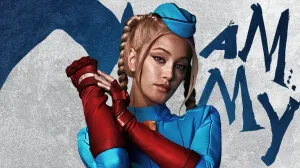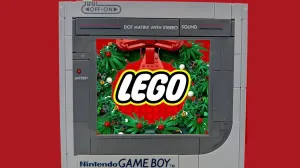The new season of Daredevil is being touted by critics and fans as one of the best offerings from Marvel Television yet.
Videos by ComicBook.com
The Netflix series goes back to basics on what made the first season work, offering a compelling character drama featuring Matt Murdock and his arch nemesis Wilson Fisk in a battle for New York City.
But it also has some of the best action scenes in the show, and that’s saying something considering all of the memorable fights that were in the first two seasons. Many fans have already pinpointed the fourth episode of the series, “Blindsided,” for having one of the best patented hallway fights in a Netflix show.
In the episode, Murdock uses Foggy’s ID to get access to a prison in hopes of speaking to a group of gangsters for more insight on Fisk’s plans. He gets drugged by someone on Fisk’s payroll, kicking off a brutal 11 minute fight scene where the Devil of Hell’s Kitchen has to fight his way through prisoners and guards. The setting quickly erupts in a riot, and Murdock narrowly escapes out the prison gates and into a taxi cab.
Most impressive about this scene is that it is all accomplished in one filming take, without any edits.
We caught up with the director of the episode, Alex Garcia Lopez, who broke down everything that went into making that scene work from a technical aspect, the emotion and brutality driving the scene, and how he and the crew were able to pull it off.
ComicBook.com: How much of this scene was planned in advance? Was it in the script from day one that this was gonna be one long take, and or when did you realize that this was something that was gonna be a huge feat for you as the director?
Alex Garcia Lopez: Yeah, that’s a good question. I mean, so basically, when you go out … TV schedules are quite sort of insane, right? So you have about only eight days of prep. You show up. You’ve got eight days of preps to work with every department, to work on the script, to work with the actors. And then you shoot. Then you’ve got about … depending on how big the script is and how demanding it is, then you’ve got about nine to 10 days to film it.
So those eight days of pre productions are full on, and you are … while they’re filming another episode. So every department is working, but then you very quickly have to pitch ideas and get everyone on board, and get everyone to help you achieve want you want to achieve. I usually get the script the first day of prep, and I arrive, and I’ve read it, and I loved it. And I started reading it, and in page … I think it was around page 11 or 12, Matt is drugged in that office. He gets on the phone. He speaks with Fisk, and then he hangs up, and he does what eventually ended up being on screen. But it was all written as scenes, right?
So, he fights his way out of the office, cut. Then next scene he goes down the hallway, bumps into other guys, cut. Until he gets to the taxi, it was 12 pages of a sequence divided by however many scenes it was. So I don’t remember, but eight or nine scenes. Whenever you first read a script, you’re mind’s kind of like a blank page a little bit, and you’re very excited. You’re not thinking about logistics yet, you’re not thinking about budget, or anything. You’re just kind of like getting inspired, right? You’re just reading it, and all these ideas start to kind of come at you, some good ones, some bad ones, and you start writing some stuff down that just literally as you’re reading, just jump out at you.
And the moment I finish reading that I was like, “Oh, my God, there’s this amazing opportunity here to do that whole thing as a one-er.” So, I thought about it for a few hours, what have you. And then I got on the phone with showrunner,Erik Oleson, and I pitched it to him. I say, “Look, I think … ” What Erik’s vision for the whole season was to be … do something different than what happened in season two, with the whole ninja thing and Elektra thing. It was much more about making it very visceral, right? About making it very grounded and subjective to be with Matt, to be with Foggy, or Fisk, or whoever’s character is leading that storyline, or that episode to be very much with them. Matt obviously up to that point, up to episode four, he’s in the self destructive, lonely, dark place, completely away from his loved ones.
And he’s just on this slightly suicidal journey to bring down Fisk at whatever cost. And he’s not making right decisions. He’s not thinking straight. He’s not physically what he used to be, and mentally. And he goes to a prison after stealing his friend’s wallet, so he’s making desperate and very anxiety-driven decisions that completely always backfire to him a little bit. And then it happens in the prison. He gets attacked by Fisk, by the guards, by the prisoners. And so, that desperation, that kind of anxiety, that claustrophobia felt right also in terms of character, and in terms of emotional beats to being a one-er, because the moment they start doing a one-er, right? After a minute or two, naturally the audience starts to feel that way, right? You start to be edging closer to the edge of your seat. You start to feel, “Oh, my God, what’s happening? How much longer?”
So all those things that one-ers are known for and are great to do. Alfonso Cuarón, obviously, I’ve mentioned him a few times, because in Children of Men, he did that to great success. And it wasn’t just fight sequences. That’s when I told Erik, I was like, “When we get to the part of the Albanians … ” Erik was like, “Right, so then we cut, right? Then we go to sort of coverage.” I said, “No, that’s when we keep going.” You know?
At that moment, Matt is out of breath. He’s dying. The drugs are getting worse. He can barely stand up on his feet. And now, he has to trust the Albanians, A, not to kill, not to stab him. And B, to work together against a common enemy, Fisk. So that’s when we keep going, because at that moment, people are gonna be like barely breathing, just like him. It’s gonna feel like we’re right there with him. So all those things felt right. And then it was the case, “Right. How do we do it?” Which then was like a … Then it was like, “Uh-oh, okay, so I pitched this idea. Marvel loved, Erik loved it. And now, how do we pull it off?” Yeah, which was the second part of that.
ComicBook.com: Sometimes they sneak edits in those kinds of sequences. Were there any cuts that are hidden in there that people might not notice?
Alex Garcia Lopez: No. No, and honest to God, there is not a single … I was very aware of that. In Season 2, they did that amazing fight where it’s played up as a one-er, but you could see the cuts. [Director Alejandro] Iñárritu does a lot. He did that with Birdman, obviously, where it’s kind of intentional a little a bit, but … One thing I told Chris LaVasseur, the director of photography, and Jeff [Dutemple], the camera opera, was like, “Stay wide.” We went with a wide lens. We were always pretty wide at mid-shot the whole time, so there was … at no point was there a moment where people were going, “Oh, wait, they used the wall, or they used the shoulder.”
We kept it very wide on purpose knowing that the plan B in a way, the sort of emergency button was when after he beats up the guards, the prison alarms start going off, because the riot’s breaking out and we cut to the alarms are going red, and then darkness. Red and darkness. We knew the worst case scenario if we had to, we could use the black out to get out of it, but we didn’t have to. And if anything, Chris LaVasseur, and Erik, the showrunner, they brought up the gain in the color grade, so that when it goes to darkness, they brought up the brightness, so that you still see it. You still see that it’s still the same shot, and we never cut away from it. So honest to God, it’s however long it is, 11 minutes, it’s just one shot.
ComicBook.com: How many takes did it take? How many days?
Alex Garcia Lopez: So, it was a work in progress, right? While we started filming the episode, Gary [Stearns], the stunt coordinator, and his team, [Chris Brewster and Don L. Lee], they were rehearsing constantly, daily — with Charlie [Cox, Matt Murdock actor], without Charlie — and improving it, right? And they would send me the videos, and then I would get some feedback. “Ooh, that moment feels a bit too long.” Or, “That’s a bit too much.” But I will give him very small feedback. Those guys are the masters of their craft, and you just kind of shape it a little bit. But they were working on it non-stop in a way. Sometimes just in the studio.
So then we ended up getting to the location and we had a whole day of rehearsals, so production shut down for the whole day, where … It’s one thing to rehearse the whole thing with stunt people, who are amazing at what they do, and with Charlie, who’s also an incredible actor. Most people cannot do what he does, and he’s amazing.
And then there’s another level of bringing in the production. You need a cameraman there. You need a focus puller. You need a sound boom op, and you need all the rest of the departments to help. So we had a whole day to rehearse the whole sequence with every department.
We planted throughout the journey little glasses of blood that Charlie grabs and drinks. And then when he gets hit, he sort of spits them out. All the light cues had to go. When the grenade explodes, that’s all real. That’s not VFX, so every department. The smoke, the smoke that all the grenades are going in, that’s all done practically to get the feel great. If it was too heavy, then you can’t see anything.
So, we rehearse the whole day with every single department and it felt good. And then the next day, we had a day to shoot it. It’s a 12 hour day when you shoot usually. But we didn’t really have 12 hours, because Gary [Stevens, stunt coordinator] told me, warned me, that because of the difficulty and the challenges of choreography, you can only really ask your stunt team to do that four, five, six times. After that, it becomes dangerous, because they start becoming fatigued. They’re tired, and then some go wrong, right? Someone could break an arm, or a leg, or what have you.
So, miraculously, we started filming very early, 6:00 or 7:00 AM. And we did the first take, it went all the way through, from beginning to end, until Matt got into the taxi. We called cut, and even though there was some little hiccups throughout the way, we did it. And that was a huge boost.
It was like 7:00 in the morning and everyone just went crazy. It was like drinking 10 espressos. People just went nuts. And then it totally blew up in our faces, because then take two, three, four, and five, I think, total false starts. We kept hitting this wall in that first office scene, which was very hard to do on a technical level, and then everyone’s confidence faded away a little bit at that point, because we kept hitting walls right there, right? And then we did … I think it was take six, we did one, and it felt amazing, and we broke for lunch.
And we broke for lunch, Charlie, and me, and it felt like we could do one more, that we could really nail it, because there was some little things when he meets the Albanian that we wanted to perfect a bit more on a pure character performance. So we came back from lunch and we did it one more time, and that was the one. That was take seven, I believe, was the one that ended up being in the cut.
Daredevil Season 3 is now streaming on Netflix.








